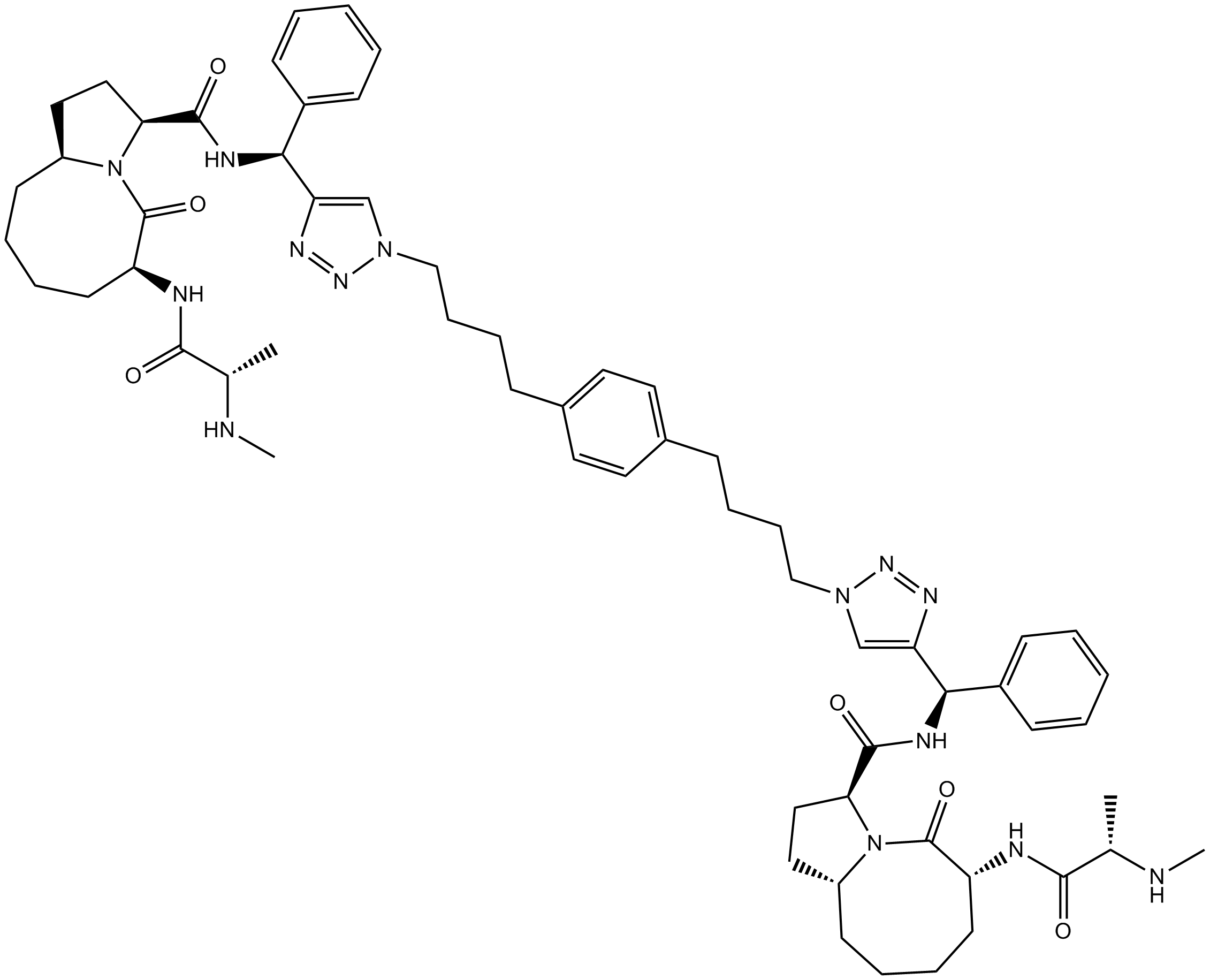| Description: |
SM-164 is a cell-permeable Smac mimetic compound. SM-164 binds to XIAP protein containing both the BIR2 and BIR3 domains with an IC50 value of 1.39 nM and functions as an extremely potent antagonist of XIAP. |
| Target: |
XIAP:1.39 nM (IC50)
cIAP-1:0.31 nM (Ki)
XIAP:0.56 nM (Ki)
cIAP-2:1.1 nM (Ki)
cIAP |
| In Vivo: |
SM-164 is evaluated for its ability to inhibit tumor growth. SM-164 is highly effective in inhibition of tumor growth and capable of achieving tumor regression in the MDA-MB-231 xenograft model. Treatment with SM-164 at 1 mg/kg completely inhibits tumor growth during the treatment. Treatment with SM-164 at 5 mg/kg reduces the tumor volume from 147±54 mm3 at the beginning of the treatment (day 25) to 54±32 mm3 at the end of the treatment (day 36), a reduction of 65%. The strong antitumor activity by SM-164 is long lasting and not transient. SM-164 at 5 mg/kg is statistically more effective than Taxotere at the end of the treatment (P<0.01) or when the tumor size in the control group reached 750 mm3 (P<0.02)[2]. |
| In Vitro: |
SM-164 is a non-peptide, cell-permeable, bivalent small-molecule, which mimics Smac protein for targeting XIAP. SM-164 binds to XIAP containing both BIR domains with an IC50 value of 1.39 nM, being 300 and 7000-times more potent than its monovalent counterparts and the natural Smac AVPI peptide, respectively. SM-164 concurrently interacts with both BIR domains in XIAP and functions as an ultra-potent antagonist of XIAP in both cell-free functional and cell-based assays. SM-164 targets cellular XIAP and effectively induces apoptosis at concentrations as low as 1 nM in leukemia cancer cells, while having a minimal toxicity to normal human primary cells at 10,000 nM[1]. The binding affinities of SM-164 to XIAP, cIAP-1, and cIAP-2 proteins are determined using fluorescence-polarization based assays. SM-164 has a Ki value of 0.56 nM to XIAP protein containing both BIR2 and BIR3 domains. SM-164 has a Ki value of 0.31 nM to cIAP-1 protein containing both BIR2 and BIR3 domains. SM-164 binds to cIAP-2 BIR3 protein with Ki values of 1.1 nM. Addition of exogenous TNFα can significantly enhance the activity of these Smac mimetics, especially for SM-164, in resistant cancer cell lines such as HCT116 and MDA-MB-453[2]. |
| Kinase Assay: |
A set of sensitive and quantitative fluorescence polarization (FP)-based assays are developed to determine the binding affinities of our designed Smac mimetics to XIAP BIR3, XIAP containing both BIR2 and BIR3 domains, cIAP-1 BIR3, cIAP-1 containing both BIR2 and BIR3 domains, and cIAP-2 protein. The FP-based assay for XIAP BIR3 protein is measured. Briefly, 5-carboxyfluorescein is coupled to the lysine side chain of a mutated Smac peptide with the sequence (AbuRPFK-Fam) and this fluorescently tagged peptide (named SM5F) is used as the fluorescent tracer in FP-based binding assay to XIAP BIR3. The Kd value of this fluorescent tracer is determined to be 17.9 nM to XIAP BIR3. In competitive binding experiments, a tested compound is incubated with 30 nM of XIAP BIR3 protein and 5 nM of SM5F in the assay buffer (100 mM potassium phosphate, pH 7.5; 100μg/mL bovine gamma globulin; 0.02 % sodium azide)[2]. |
| Cell Assay: |
HCT116 colon cancer cells are treated with SM-164 (1, 10, and 100 nM) alone, TNFα alone, or the combination for 48 h. Cell growth inhibition is determined by a WST assay[2]. |
| Animal Administration: |
Mice[2] SCID mice (8-10 per group) bearing MDA-MB-231 xenograft tumors are treated i.v. with 1 and 5 mg/kg of SM-164 or 7.5 mg/kg of Taxotere or vehicle control daily, 5 d/wk for 2 wk. Tumor sizes and animal weights are measured thrice a week[2]. |
| References: |
[1]. Sun H, et al. Design, synthesis, and characterization of a potent, nonpeptide, cell-permeable, bivalent Smac mimetic that concurrently targets both the BIR2 and BIR3 domains in XIAP. J Am Chem Soc. 2007 Dec 12;129(49):15279-94.
[2]. Lu J, et al. SM-164: a novel, bivalent Smac mimetic that induces apoptosis and tumor regression by concurrent removal of the blockade of cIAP-1/2 and XIAP. Cancer Res. 2008 Nov 15;68(22):9384-93. |






















